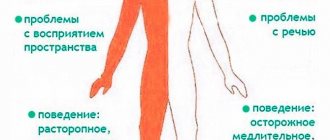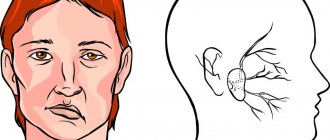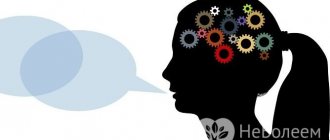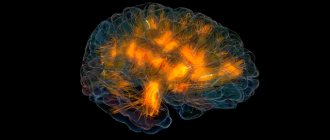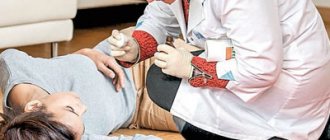Types of disease
Stroke is a pathology accompanied by impaired blood circulation in certain areas of the brain. The condition is accompanied by oxygen starvation and a severe deficiency of nutrients, which ultimately leads to the death of brain cells. As a result, there is a complete or partial loss of functions for which the affected area was responsible.
Depending on the underlying cause, there are two types of stroke:
- Ischemic (most common). It is a consequence of blockage of the lumens of cerebral vessels. The disease progresses slowly and is not accompanied by hemorrhage, but is accompanied by the death of brain cells.
- Hemorrhagic. Caused by hemorrhage in the brain tissue as a result of rupture of a local vessel. Due to the accumulation of blood and pressure exerted on a certain area of the brain, its functions are impaired.
Important! The cause of a stroke may be cerebrovascular disease.
Symptoms, signs and first aid
Anyone can have a stroke, which is why it is so important to know the primary symptoms of the condition. It is indicated by:
- weakness in the limbs;
- fainting conditions;
- numbness of half the face, distortion of features;
- Strong headache;
- speech impairment, misunderstanding;
- various visual impairments;
- complete or partial paresis;
- impaired coordination of movements up to its complete loss;
- impaired skin sensitivity;
- instability and tension of the pulse.
If we talk about what pressure is possible during a stroke, then its indicators can be both low and high. To make sure that the patient has had a stroke, he must be asked to perform several familiar actions. For example, smile broadly or say a few words. He will not succeed: the affected part of the face will remain motionless, and speech will be unclear, as if the person’s mouth is filled with porridge and he is trying to speak through it.
What to do if this happens? First of all, immediately call an ambulance. Lay the patient down so that the head is elevated in relation to the legs, unbutton the collar, and remove the woman’s bra. A person must breathe deeply. Trying to lower blood pressure on your own is strictly prohibited.
THE BEST YOU CAN DO
— Sergei Nikolaevich, what else can’t be done while waiting for the ambulance to arrive? What mistakes do loved ones most often make when trying to help a sick person?
- In fact, the best that those around them can do is to lay the person down, give him a horizontal position. You can put something under your head so that it is slightly raised. It is absolutely forbidden to take any other actions if you do not have a medical education.
- That is, giving water to drink, drips of Corvalol or Validol under the tongue - all this is contraindicated?
- Yes, I repeat: do nothing, just wait for the ambulance.
— Many people remember that at the height of the Covid epidemic, cars on “03” arrived with a long delay due to the huge flow of patients. In some regions, the epidemiological situation is still difficult. How long after a stroke is it important to ensure that the patient is taken away by ambulance?
— There is a so-called “golden hour”, during which a patient with a stroke needs to be taken to a medical facility and medical care begins. More precisely, this is the first four hours from the moment of stroke development, in medical language - the “therapeutic window”. At this time, it is necessary for the patient to be taken to a hospital where it is possible to conduct a computed tomography scan, and after it they begin to use thrombolytic therapy (in simple terms, to dissolve a blood clot that has blocked a vessel in the brain. - Ed.). If you managed to meet these four hours, then the treatment results are likely to be good.
What blood pressure can trigger the development of a stroke?
At what blood pressure level can a stroke occur and can the condition develop at normal blood pressure? It is worth noting that most often a stroke occurs in hypertensive patients. The reasons are:
- Stably high blood pressure, which does not decrease even while taking medications;
- sharp jumps in indicators caused by a stressful situation or significant physical activity;
- refusal of treatment for hypertension and heart disease.
Doctors call the physiological level of blood pressure, at which all body systems operate in a natural mode, a level of 120/80 mm. rt. Art. When it increases to 180/120, we can talk about the development of a hypertensive crisis, which can quite easily turn into an apoplexy (stroke).
The danger in terms of the development of pathology is represented by too small a difference between the upper and lower blood pressure readings. If it is less than 40 units, then the likelihood of blockage of the vascular lumen increases significantly. Therefore, a blood pressure of 130/110 is more likely to trigger the development of a stroke than a blood pressure of 160/90.
No ads 1
Is it possible to protect yourself from a stroke? 6 questions to a specialist
1. Why does a stroke occur?
To make it clearer, let’s immediately divide all strokes into two fundamentally different types: ischemic and hemorrhagic. The first is associated with a violation of blood flow to a certain area of the brain; according to the mechanism of development, it resembles myocardial infarction. The second develops as a result of hemorrhage in the brain, most often due to the rupture of an aneurysm (local dilation of the vessel with thinning of the wall) of one of the cerebral arteries. This pathology is often congenital, and aneurysms can also form during life as a complication of hypertension. Hemorrhagic strokes are less common and are more severe than ischemic strokes.
2. How does cardioembolic stroke develop?
The ischemic ones themselves - in contrast to the main cause that caused the blockage of the artery - are divided into atherosclerotic and cardioembolic. Atherosclerotic - the most common: a plaque located in the carotid, vertebral or one of the intracerebral arteries ruptures, its fragments rush to the brain, and then blood clots try to “patch” the site of the formed defect, but in fact they only worsen the situation.
It’s a different story when a blood clot came from the heart cavity. Why did he appear there? Most often, against the background of the development of arrhythmia, for example, atrial fibrillation, when the atria begin to contract not measuredly, but chaotically, like a butter churn, churning stagnant blood. Sometimes, when a post-infarction aneurysm develops in the heart after a heart attack, a large blood clot can form unnoticed in its cavity. Infectious damage to the valves - infective endocarditis is also often complicated by the separation of weakly fixed microbial vegetations from the valve and the development of cardioembolic stroke.
3. What factors lead to stroke?
Risk factors often “work” for several decades before a stroke. Long-term causes of stroke are bad habits, and above all smoking, alcohol abuse, unhealthy diet with a predominance of animal fats and easily digestible carbohydrates (fast food, cola, pork kebab and mayonnaise), physical inactivity, and obesity. Diabetes mellitus, especially type 2, which in our time is becoming an epidemic, makes a big contribution.
A separate story is hypertension.
WHO recently lowered the blood pressure threshold from 140/90 mmHg. Art. up to 130/80 mm Hg. Art.
An occasional increase in blood pressure above these figures requires medical supervision and the beginning of systematic blood pressure monitoring, non-drug, and possibly medicinal treatment methods.
4. What does it mean that a stroke is approaching?
One of the first “bells” of a possible stroke may be the development of a hypertensive crisis. It is no secret that against this background, as well as in the immediate period after the crisis, the frequency of strokes (both ischemic and hemorrhagic in nature) increases significantly. If a crisis does occur, it is necessary to begin permanent drug treatment for hypertension as quickly as possible. It’s probably not even worth talking about the fact that it’s high time to quit smoking and abusing alcohol.
5. What is a pre-stroke condition?
The next step, and this is by no means a ringing bell, but a real ringing of the bell, is the development of a transient ischemic attack (TIA) or transient cerebrovascular accidents. Some incorrectly call this syndrome a pre-stroke condition, although the essence of the phenomenon is close.
Clinically, the pathology is manifested by dizziness and headaches. They can occur suddenly, or they can precede for several days the main symptom of the disease, which is
*short-term weakness in the arm and leg on one side of the body,
*short-term loss of vision or speech,
*sudden transient global amnesia - loss of short-term memory for events preceding and accompanying TIA, lasting up to a day. At the same time, long-term memory (usually for events a week ago before the attack and beyond) is preserved.
30−50% of people who have suffered a short-term cerebrovascular accident within five years develop a stroke, so they require a comprehensive examination and follow-up by a neurologist.
6. What is the algorithm for preventing stroke?
Let's try to imagine a stroke prevention scheme for a middle-aged person.
*A prerequisite is a healthy diet, giving up bad habits, maintaining normal body weight and daily physical activity.
*Examination for susceptibility to atherosclerosis: taking into account heredity, blood test for lipid profile, ultrasound of brachiocephalic arteries with assessment of the thickness of the “intima-media complex” (an expert method for early diagnosis of atherosclerosis). If elevated levels of “bad” cholesterol and signs of atherosclerosis of the carotid arteries are detected, discuss with your doctor the issue of prescribing drugs that lower cholesterol levels.
*24-hour (Holter) monitoring of ECG and blood pressure to identify “hidden” hypertension and possible heart rhythm disturbances that threaten cardioembolic complications. It is recommended not to allow periodic increases in blood pressure above 130/80 mmHg. Art. If rhythm disturbances are detected, additionally perform cardiac ultrasound (EchoCG).
*MRI of the brain with X-ray contrast agent to identify possible aneurysms of the cerebral arteries. If they are detected, it is possible to perform low-traumatic endovascular clipping of aneurysms or open surgery.
Acceptable indicators and pressure deviations after impact
What blood pressure should a patient have after a stroke? Everything will depend on the type of pathology.
Ischemic form
During the first few hours after the formation of the condition, almost all patients experience high blood pressure. This is a protective reaction of the brain aimed at stabilizing the work of the myocardium. That is why a specialist should select antihypertensive drugs, taking into account the current condition of the patient.
Incorrectly selected medications can reduce blood pressure too much. The worst outcome in this case may be the death of a person. In addition, recovery after a stroke will be longer and more difficult.
Indications for emergency reduction of blood pressure are:
- increase to 180/220–100/120 mm. rt. st;
- the need to administer an antithrombotic agent;
- development of systemic circulatory failure;
- diagnosing aneurysm/arteriovenous malformation of cerebral vessels;
- disorders of the kidneys.
During the first 48–72 hours after an ischemic stroke has occurred, blood pressure can be reduced by no more than 15% relative to the existing one. At this time, increased blood pressure is normal.
Important! In patients who do not have a history of hypertensive pathology, blood pressure should not fall below 165/95 mm. rt. Art. In the presence of the disease, the minimum level is determined by 185/105 mm. rt. Art.
It is very important to protect the patient from factors that can provoke a sharp increase in blood pressure. These include nervous tension, severe pain, and fluid retention.
Hemorrhagic form
This type of stroke occurs against the background of a significant increase in blood pressure, so antihypertensive therapy should be started as early as possible. Taking medications helps:
- reducing the volume of the hematoma, stopping its spread;
- decrease in intracranial pressure;
- blocking the development of swelling of brain tissue.
The critical level of blood pressure, upon reaching and overcoming which it is necessary to take measures to reduce, is considered to be 140/90 mm. rt. Art. But the decline should be gradual. During the day, it can be lowered only by 20% relative to the current one.
No ads 2
Low and high blood pressure
During the first 24 hours after the impact, maintaining high blood pressure is an acceptable norm. The danger is high blood pressure that persists for a week after a stroke. The symptom indicates incorrect treatment. In this case, the patient becomes incapacitated and develops neurological disorders.
Such negative consequences for the patient’s health are due to the continuing increase in cerebral edema, which results in wedging of the brain stem into the occipital part. It is possible that breathing processes may be disrupted until a critical condition develops, as well as heart failure and cardiac arrest.
Complications of hypertensive crisis
If the pressure, despite the therapy, still jumps, then the consequences may be as follows:
- re-strike;
- expansion of the ischemic focus;
- development of encephalopathy;
- hemorrhage in the skull.
Why does a patient have low blood pressure after a stroke and why is this condition considered negative by doctors? A rapid decrease in blood pressure occurs against the background of the following pathological conditions:
- development of a major stroke;
- brain stem damage;
- the formation of cardiogenic shock against the background of a heart attack;
- heart rhythm disturbance;
- dehydration;
- blockage of the pulmonary arteries;
- blood poisoning;
- aneurysm.
Low blood pressure values during the rehabilitation period indicate progression of the pathology. The prognosis in this case is extremely unfavorable, this applies to both recovery and human life. A decrease in blood pressure can occur against the background of regular use of hypertensive drugs that were prescribed to the patient even before the stroke developed.
But if the reason for this is not drug treatment, then this is a signal that the body is unable to independently regulate blood pressure as a result of impaired cerebral blood circulation. Medical statistics show that severe hypotension during the first few days after a stroke causes the death of the patient.
No ads 3
Causes of blood pressure surges
A sharp fluctuation in blood pressure after a stroke occurs when the organs and systems of the body are unable to perform their functions. Most often it is the brain that is affected. Against the background of unstable blood pressure, both cardiac and peripheral circulation worsens, and the destruction of the walls of blood vessels also occurs. The patient develops an acute form of atherosclerosis. The development of recurrent strokes cannot be ruled out.
The main danger lies not in the increase or decrease in pressure, but in its constant fluctuation
The leading causes of sudden changes in blood pressure that occur after a stroke are:
- disturbances in the functioning of the central nervous system;
- low mobility of the vasomotor center;
- high blood sugar levels;
- hormonal imbalance;
- changes in the electrolyte composition of the blood.
Important! With a hemorrhagic stroke, the risk of developing a second stroke is high. This usually happens on the fifth or sixth day after the first blow.
Stroke in hypotensive patients
The development of a stroke is also possible with low blood pressure (in people suffering from hypotension). The formation of pathology is due to the body’s inability to independently eliminate the impending blow. A stroke in hypotensive patients can be triggered by features of a person’s lifestyle, stressful situations, disturbances in the functioning of internal organs and systems as a whole, and the use of antihypertensive medications.
The cause of stroke development against the background of hypotension can be:
- a sharp increase in blood pressure - occurs as a result of severe stress, overwork, as a side effect of the drug;
- rupture of an aneurysm - can be triggered by lifting weights, staying in a prolonged inclined position in hot rooms or under the open sun - a violation of the integrity of the vessel occurs as a result of overstrain;
- bleeding disorder - in this case, the likelihood of blood clots and blockage of blood vessels in the brain increases.
In the chronic form of hypotension, the likelihood of developing an ischemic stroke increases significantly with age. In the presence of cardiovascular pathologies, the risk of hemodynamic stroke increases. This is a subtype of the ischemic form, caused by circulatory decompensation. Its cause may be:
- atrioventricular block;
- myocardial infarction;
- weak sinus syndrome;
- atrial fibrillation.
Parkinson's disease is often accompanied by hypotensive crises, which, in turn, can cause the development of hemodynamic stroke. In hypotensive patients, signs indicating the formation of a hemorrhagic form of stroke are almost completely absent.
The condition is characterized by a slow onset and a long period of persistence of symptoms of brain damage with low blood pressure. The patient does not experience loss of consciousness or headaches. But almost all the precursors are typical for ischemic stroke. Most often, symptoms occur at night or in the morning.
[node:field_similarlink]
What kind of stroke happens?
There are two main types of stroke: ischemic and hemorrhagic. Both cases are extremely dangerous because when brain cells stop receiving oxygen, they die.
Hemorrhagic stroke
- occurs due to bleeding in the brain. Vessel rupture can occur due to a sharp jump in blood pressure, the presence of an aneurysm or atherosclerosis. In most cases, a person experiences a sharp headache, suddenly loses consciousness, and sometimes there may be convulsions. If someone near you has lost consciousness, do not waste time, call an ambulance.
Ischemic stroke
– occurs in most cases and may develop over time. Often it occurs due to blockage of a vessel by a blood clot, vasospasm, or compression due to injury or tumor.
A precursor to a stroke can be a transient ischemic attack—a short-term disruption of the blood supply to the brain. Brain cells are damaged but not killed. A TIA significantly increases the risk of stroke and requires medical evaluation.
A stroke has a number of symptoms, which, if noticed, can save a person’s life.


